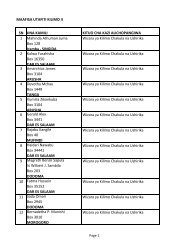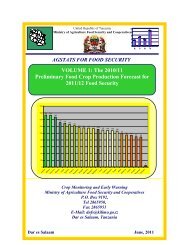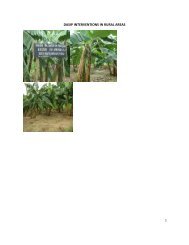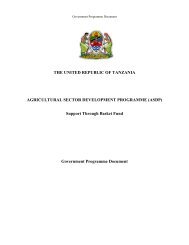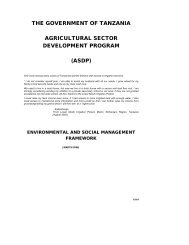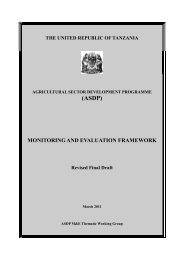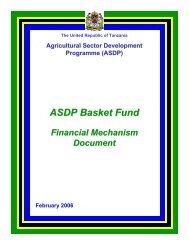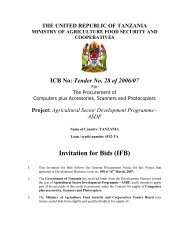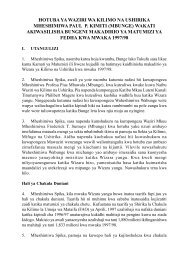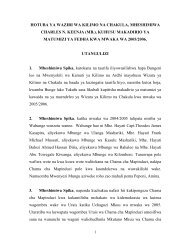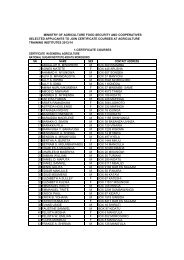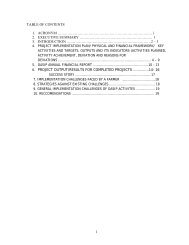Large Scale Farm Report - Ministry Of Agriculture, Food and ...
Large Scale Farm Report - Ministry Of Agriculture, Food and ...
Large Scale Farm Report - Ministry Of Agriculture, Food and ...
You also want an ePaper? Increase the reach of your titles
YUMPU automatically turns print PDFs into web optimized ePapers that Google loves.
EXECUTIVE SUMMARYxivDuring short rainy season, beans were grown on 68 large scale farms covering an area of 886 hectares producing 933tonnes. The area harvested was 882 recording a yield of 1.1 tones per hectare. Most of the farms were concentrated inKigoma <strong>and</strong> Mwanza followed by Kilimanjaro. The lowest numbers were in Dodoma, Kagera, Tanga <strong>and</strong> Mara. Areawise, Arusha had the largest area while Kagera had the lowest.The total area planted with beans was therefore 9,038 (11.1%) hectares of the total area grown annual crops <strong>and</strong> theproduction was 8,724 tonnes of beans making an average yield of 1.0 tonne per hectare. In 1994/95 crop year 7,443 tonnesof beans were produced.. From 1994/95 to 2002/03 there was an increase of beans production by 17 percent.• CottonCotton is mainly grown in Lake Zone. In 2002/03 crop year 1,084 hectares were planted on 21 large scale farms duringlong rainy season covering 1,084 hectares, 854 tonnes were harvested giving an average yield of 0.8 tonnes per hectare.The highest numbers of farms were in Shinyanga by 76 percent while the lowest were in Tabora, Morogoro <strong>and</strong> Manyara.Morogoro has the largest area by 58 percent while the smallest area in Tabora by only 1.2 percent. Although Shinyangacontributed 76 percent of the total farms, it contributed only 37 percent of area planted with cotton.In short rainy season cotton was grown on 30 large scale farms covering an area of 410 hectares which produced 405 tonesmaking an average yield of 1.0 tone per hectare. The largest numbers of farms were in Mwanza by 90 percent while thelowest were in Tanga (3%) <strong>and</strong> Mara (7%). The largest planted area was in Mwanza by 77 percent followed by Mara (215)while the lowest was in Tanga (2%).The total area planted with cotton was 1,494(1.9%) hectares out of the total area grown annual crops <strong>and</strong> the productionwas 1,259 tonnes of cotton making an average yield of 0.8 tonnes per hectare. In 1994/95 agriculture year 391 tones ofcotton were harvested. From 1994/95 to 2002/03 the harvest increased by 222 percent.• TobaccoTobacco is mainly grown in Tabora <strong>and</strong> Iringa region. During long rainy season 12 large scale farms were grown withtobacco covering an area of 3,077 hectares. 5,249 tonnes were harvested giving an average yield of 4.0 tonnes per hectare.The highest numbers of farms were in Tabora (50%) <strong>and</strong> Iringa (42%). The lowest number was in Ruvuma by 8%. In shortrainy season tobacco was grown in Kigoma only on 1 large scale farm covering an area of 2 hectares which produced 1tone making an average yield of 0.5 tones per hectare.The total 3,079 hectares produced 5,250 tons with an average yield of 1.7 tons per hectare. During 1994/95 agriculture year649 tonnes were harvested. From 1994/95 to 2002/03 the harvest increased by 709 percent.(iii) Permanent Crop ProductionThe permanent crops were grown on 1,173 large scale farms covering 109,940(9.9%) hectares out of the total area of1,105,125 hectares covered by all large scale farms. In 1994/95 agriculture year 796 large scale farms were planted withperennial crops which covered about 98,575 hectares. From 1994/95 to 2002/03 the number of large scale farms plantedwith perennials increased by 47 percent while the area increased by 12 percent (from 98,575 hectares in 1994/95 to109,940 hectares in 2002/03). Also there was an increase in production for most of the perennials, few perennials theirproduction dwindled. The most important permanent crop is sisal which accounts for 32.5 percent of the total area plantedwith perennials followed by sugar cane (16.0%), coffee (10.8%) <strong>and</strong> tea (9.5%).Tanzania <strong>Agriculture</strong> Sample Census – 2003



